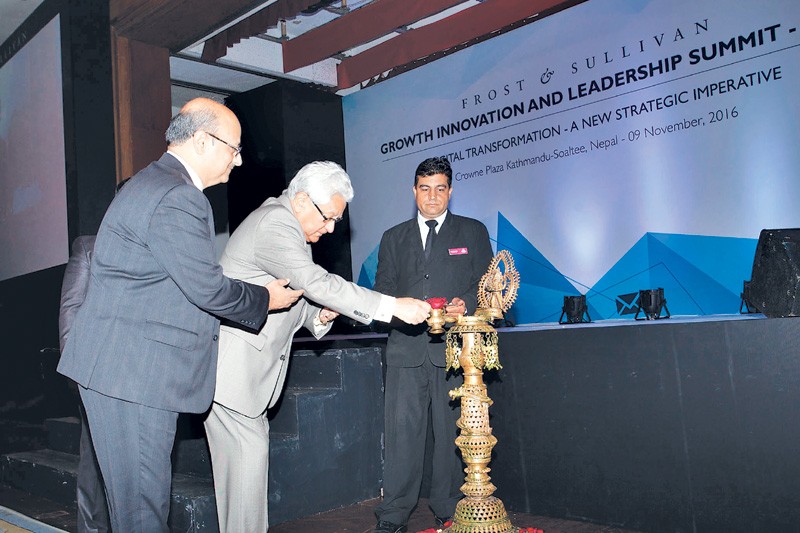Picture: Prabhakar SJB Rana (centre), Chairman Emeritus of Soaltee Hotel Limited, inaugurates Growth, Innovation and Leadership Summit organised by Frost & Sullivan in Kathmandu on Wednesday.
Let’s begin on a light note!
After God decided to create the universe, He summoned his architects and consultants and said He wanted to create a country with marvellous natural beauty and rich biodiversity that would make people of other countries react with awe.
“Let’s bless that country with eight peaks that rise above 8,000 metres, so that it becomes a hub for mountain expeditions,†He said. “Let’s also cover large swathes of that country with forests and medicinal plants, and fill it with rivers so that it can harness tonnes of power. Also, let’s put the country in between the two biggest markets in the world.â€
God then said: “We’ll name that country Nepal.â€
His architects and consultants got worried. “If all of these resources are injected in one country, it will dominate the world,†they said.
God then smiled and said: “Don’t worry I’ll also give that country a bunch of politicians who can never deliver.â€
The joke in this line was shared by Binod Chaudhary, chairman of Chaudhary Group and first Forbes-listed Nepali billionaire, at the Growth, Innovation and Leadership Summit organised by Frost & Sullivan, a global consulting firm headquartered in the US, on Wednesday.
His joke did amuse the audience for a while but they soon realised what Chaudhary just shared was not a joke at all but a reality in Nepal.
Nepal, which has stunning scenic beauty, for instance, does not even draw 1 million tourists a year. It has the potential to generate over 40,000 MW of electricity through hydro resources, but actual production stands at less than 900 MW, making lengthy power cuts perennial here.
What’s more, the country’s strategic location between China and India — two largest markets in the world that investors from across the globe want to penetrate — has not been exploited to give the sagging domestic economy a much-needed leg up.
It is therefore not surprising that “youths here have started losing hope†and many who have gone abroad for various purposes “do not want to return to the countryâ€, Chaudhary told the summit.
“So, right opportunities have to be created on right time …. otherwise future generation will not forgive us,†he said, urging politicians not to play “politics†all the time.
The practice of politicians and the government making tall promises, but failing to fulfil them is not a problem faced by Nepal alone, according to Idris Jala, CEO of Malaysia’s Performance Management and Delivery Unit (PEMANDU) in the Malaysian Prime Minister’s Department, which is tasked with spearheading Malaysia’s transition towards high-income status by 2020.
“Most governments have great strategies and plans but they fail to [translate] them into detailed programmes for implementation,†Idris said.
Idris’s own country Malaysia also suffered from this problem for decades. In 1991, for instance, Malaysia had launched a document called Vision 2020 to graduate to the grouping of high-income nations. But nothing happened for the next two decades.
Then in January 2010, Malaysia launched the Government Transformation Programme, which sought to deliver big results in public services to ease lives of its citizens. This was followed by introduction of the Economic Transformation Programme, a roadmap for graduation to the grouping of high-income nations by 2020. “To identify projects to implement these programmes, we ran a lab for eight weeks,†Idris said. The participants of the lab, according to Idris, were civil servants, opposition political leaders and people from the private sector.
“These people conducted analysis of real problems facing the country and ways to resolve them. They then came up with 131 projects worth US$406 billion,†said Idris, adding, “It was easy to implement those projects because the lab participants had also framed detailed plan of action.â€
To monitor whether progress was being made, various targets were given to project implementers. “We then started publishing progress reports every Friday,†Idris said, and quipped, “We chose Friday for this purpose to ruin the weekend of officers of projects not doing well, as they’d be called by ministers and prime minister and told to enhance performance
immediately.â€
Thanks to all these efforts, Malaysia is no longer stuck in mid-income trap, with worsening fiscal deficit. Also, 65 percent of investment now comes from private sector, as against 52 percent in 2009. “Transformation requires commitment from political leadership,†Idris said.
Like Malaysia, Nepal also does not have dearth of development plans. Take a look at the list of national pride projects, for instance.
The project bank, first introduced in 2012, now contains 21 development projects, including four irrigation projects, three hydropower projects, three international airports, six roads projects, an electric railway project, a drinking water project, two projects aimed at promoting holy sites of Pashupati and Lumbini, and an environment conservation project. But construction of many of these projects has not begun yet.
“If only three hydroelectric projects included in the list were developed, the future of Nepal would be very bright,†said Saurya SJB Rana, president of the Nepal-India Chamber of Commerce and Industry.
By Rupak D Sharma







